
 Canada Bach, Beethoven, Honegger, Ysaÿe: James Ehnes (violin), Andrew Armstrong (piano), Carissa Klopoushak, Christina Bouey, Amy Hillis, Emmanuel Vukovich (violins), Cameron Crozman (cello), Richard Raymond (piano). Bourgie Hall, Montréal Museum of Fine Arts, Montréal. 14.6.2019. (LV)
Canada Bach, Beethoven, Honegger, Ysaÿe: James Ehnes (violin), Andrew Armstrong (piano), Carissa Klopoushak, Christina Bouey, Amy Hillis, Emmanuel Vukovich (violins), Cameron Crozman (cello), Richard Raymond (piano). Bourgie Hall, Montréal Museum of Fine Arts, Montréal. 14.6.2019. (LV)

Concert I
Bach – Sonata, BWV1001: Adagio and Presto; Partita, BWV1004: Chaconne
Ysaÿe – Sonata No.5, in G major; Sonata for 2 violins, Op.27
Honegger – Sonatine for violin and cello, H.80
Concert II
Beethoven (arr. Liszt) – Symphony No.4, Op.60; Symphony No.5, Op.67
Concert III
Beethoven – Violin Sonatas, Op.25; Op.30, Nos. 1 and 2
It is a wonderful thing when a violinist has the composure and daring to start a concert with the cold opening of Beethoven’s Spring Sonata. For the second instalment in his complete cycle, James Ehnes had both. His intonation was pure, and his sound had undertones of wine. His complement was Andrew Armstrong’s piano, with a rock-star’s neon colors and elegant phrasing that matched Ehnes, while occasionally exceeded him in sheer flamboyance.
As much as Ehnes commanded line and made key decisions at pivotal transition points, at times Armstrong seemed mesmerized by Beethoven’s piano innovations. The music may have been written for the pianoforte, but Beethoven was always pushing boundaries, which Armstrong acknowledged throughout the evening by giving his astounding ideas great imagination and freedom. After each sonata, and having identified themselves so inseparably from the music, the duo took a few simple bows, and despite rapturous applause, there were no encores.
In the Spring, Ehnes played the final echoes of the first movement’s opening theme so poignantly that it was clear he himself was moved. In the Adagio molto espressivo the narrative was projected with such a feeling of flirting turning into love, that at the end, the audience held its breath for a moment before giving a collective sigh. After the joke of the Scherzo, and the duo frolicking in the sheer melodious beauty of the Rondo, Ehnes plucked a few of the purest of pizzicato double stops, and each threw in wonderful last riffs before rushing headlong to the end.
The two also fully enjoyed the happiness that is Beethoven in Op.30, No. 2, in A major. In the early variations of the Allegretto, they made the phrases purr, before braving the minor key confusion of the fifth variation and a final exhilarating release. Afterward, the two totally took on the stormy weather that is Beethoven in Op.30 No.2, in C minor. Following the Allegro con brio‘s initial shattering impact, Ehnes gave the spartan lines tone and color, brutally revealing a violent Beethoven hidden behind the notes; in the intense playing, it felt that life had no point. But the Adagio cantabile sweetly soothed hurts and wounds and closed with moving, noble amens. And in the final Allegro, Ehnes and Armstrong carried uncompromising Beethoven to urgent new heights.
Earlier in the day, at noon, four exceptional violinists and one exceptional cellist, all members of The Bank of Montréal’s ‘Hottest Classical Artists Under 30’, played instruments from the Canada Council for the Arts’ Musical Instrument Bank in Bach, Ysaÿe and Honegger. Carissa Klopoushak, who leads the Ironwood Quartet, played two movements from Bach’s G minor sonata with superb arcs and a rich full sound. Christina Bouey, founding member of the Ulysses String Quartet which is headed for the Banff International String Quartet Competition this year, played Ysaÿe’s Sonata 5, dedicated to the composer’s disciple Matthieu Crickboom. Playing on an instrument once owned by an Ysaÿe student, Bouey responded with the kind of beguiling poetry that technical brilliance alone cannot liberate.
Amy Hillis and Cameron Crozman played Honegger’s delightful Sonatine with adorable musical sophistication and dazzling technique, amply demonstrating that the score is perfect for listening to what lies at the heart of each instrument — and very cool besides. There is a Danse macabre tuning sequence, and two insane cadenzas in the last movement which were perfectly set up and magnificently played. Then in the Bach Chaconne, Emmanuel Vukovich lost himself so completely, and with such authentic purity and simplicity, that every note had its own purpose and a beauty, leading to a deeply profound and meditative silence. Klopoushak and Bouey concluded with more intoxicating Ysaÿe.
The day’s main event, however, took place at five in the afternoon, when Bourgie Hall presented Beethoven from an alternative universe, in which the composer had never written symphonies for orchestras but only for piano in a manner that anticipated Liszt. In fact, Richard Raymond’s performances of the Fourth and Fifth Symphonies were so massively colossal in size, energy, dynamic range, and color, that he got into Beethoven’s head on a vast immersive scale. Beyond simulating Beethoven, he eclipsed the orchestral versions, and brought the audience along with him.
The unassuming Richard Raymond, who teaches at the Conservatoire de musique du Québec à Montréal, treated both symphonies as if they were titanic predecessors of the mighty Hammerklavier with its wild untamed outbursts. The finish of the opening Allegro vivace was so insanely fast and melodramatic in a cartoonish soundtrack way that I laughed. But when the Fifth ended even more insanely, everything larger than life, I wasn’t laughing any more.
Laurence Vittes
